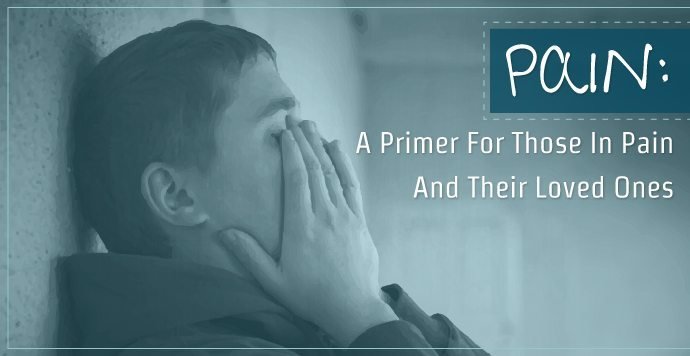PAIN: A Primer For Those In Pain And Their Loved Ones

Understanding Pain:
We have all experienced pain in our lives. This can be physical, emotional, relational, intellectual, or spiritual, and pain in one area of life can lead to pain in other areas of life. However, our focus is on acute and chronic physical pain although other pain conditions impact this. National studies indicate that 50 – 100 million Americans suffer from ongoing physical pain and pain is the leading cause of adult disability.
There are Many Definitions of Pain: The classic definition is from the International Association for the Study of Pain which states that it is an “unpleasant sensory and emotional experience associated with actual or potential tissue damage, or described in terms of such damage” and that “pain is always subjective.” In examining this definition we will need to look at the statement, “pain is inevitable, suffering is optional.”
Acute vs. Chronic Pain:
Acute pain is pain that is short in duration (from minutes to a few months) and is caused by physical trauma to the body or illness such as a small burn, a broken bone, or appendicitis. The pain may be intense, but it is of limited duration (although acute pain could lead to chronic pain if left untreated). Acute pain is a normal sensation alerting you to an injury or other medical problem. Most of us can cope with acute pain without too many complications.
Chronic pain may last for months or years, may be intermittent, and is a problem that may be unrelated to the original pain. The warning signs of acute pain now turn into problematic pain that is chronic, yet chronic pain may not be caused by an acute condition. This pain is now out-of-control as the body no longer needs a warning about the pain area; it appears to stay stuck in a pain mode. Conditions of chronic pain include low back pain, irritable bowel syndrome, fibromyalgia, migraine headaches, and arthritis.
How Pain Works: Sensory nerves, the brain, and the spinal cord are the major players in the neurobiological system regarding how the pain signal is received. But more importantly is how we perceive the pain and how it influences our lives. This is shown by the attached graph; all 5 areas also interact with each other as well as the underlying pain condition.

Physical/Biological: As already noted, acute and chronic pain is influenced from our neurobiological system and acts as a cause of pain as well as affects the outcome of pain. Pain is relative; some of us have higher pain thresholds than others. Our physical health can impact in positive or negative ways, i.e., exercise, eating healthy, and getting enough sleep can help us to cope with pain; likewise, not taking care of our physical selves can cause more physical dysfunction.
Emotional/Psychological: Our emotions play an important role in our physical health and in the experience of pain. Conditions such as depression and anxiety can influence our interpretation of pain and lead to suffering. Likewise, taking care of our emotional issues can provide us with healthy coping skills for both emotional and physical suffering.
Social/Self: Our lives need to be balanced between our relationships with others as well as our relationships with ourselves. Pain conditions can cause us to isolate ourselves; isolation can lead to depression and other emotional conditions, and can also lead us to increased physical pain. Again, if we have a healthy relationship with others and with ourselves, we can find supportive ways to cope with our physical pain, such as through hobbies and leisure activities, meditation, and friendships.
Cognitive/Intellectual: Our thought processes can hinder or help in our coping with physical pain. Negative thoughts such as, “I’ll never get better” or “this pain is killing me,” lead to negative consequences, for where our thoughts go, so goes our healing. Yet our thoughts can be beneficial; for example, if I focus my thoughts on healing and positive outcomes, I am more likely to experience relief from my pain.
Religious/Cultural/Spiritual: This category can also help or harm our coping with physical pain. For example, men in Western culture are often told to “man up” when facing any difficulty, including physical health problems. By doing so, they may add to the chronic pain condition by not seeking help from experts and by denying their condition. Yet there may be a spiritual or cultural focus which provides comfort and healing through love, acceptance, and calming practices such as meditation and prayer.
These above five areas can be complicating factors or healing factors. The list below concerns complicating factors for healing from physical pain:
Complicating Factors:
- addictions
- mental illness
- co-occurring disorders (primarily addictions and mental illness)
- cognitive or developmental disorders
- other medical problems
- psychosocial problems (poverty, poor quality of life, limited education, unemployment)
How Do These Factors Complicate Healing?
It is much easier to cope with problems if there are only 1 – 2 issues. The more negative factors involved, the more difficult it is to heal from physical pain. Yet, keep in mind that healing is healing and that healing in one area of life that can impact positively in other areas of life.
Let’s Explore Two Different Case Studies – Michelle and Pam:
Michelle: Michelle is happily married, a college graduate, has 2 supportive adult children, has 5 good friends, works a job she loves, has no psychosocial problems (such as poverty) and participates in a number of hobbies. However, she has the chronic pain disorder of fibromyalgia and her life is impacted by this pain. For the most part, the only negative in her life is in the area of physical problems. But because she participates in a variety of activities of the 5 areas of life, she is able to maintain a life of enjoyment and copes as well as possible with the fibromyalgia.
Pam: Pam not only struggles with fibromyalgia, she has migraines and chronic low back pain. However, she also has bipolar I disorder, borderline personality disorder, and is addicted to alcohol and her pain medication. She is unemployed due to her pain, but has been unable to get disability. Because of her emotional difficulties, she often struggles with relationships, and she has few self-soothing behaviors and coping skills. She is also a high school dropout and struggles with finding work. Because she is addicted to her pain medications, her physician is strictly limiting her medications, which she continues to abuse by taking more of them than prescribed and also by buying them on the streets. She is reluctant to go to substance abuse treatment because she is afraid she’ll have to go off her pain meds.
So which of these 2 women has a greater chance of healing from the physical pain? While these are extreme examples, they indicate the struggle with chronic pain, co-occurring disorders, and coping.
“Pain is inevitable, suffering is optional.” As we have seen, there are many types of pain, but how we cope with our pain is the determining factor of our lives. We can accept our chronic pain and learn healthy responses, or we can give in to suffering and be a victim of physical/emotional/relational/cognitive/spiritual suffering. This is the psychology of pain – how we interpret the pain – and whether we stay in the emotional suffering from the pain condition, or we focus on healing.
In the next article, we will explore assessing and coping with chronic pain.




